Causes and signs of perioral dermatitis - symptoms and treatment in children or adults at home. Features of oral dermatitis and ways to get rid of it
Perioral dermatitis Doctors may call it rosacea-like. The disease is rare, affecting about 1% of people.
The disease often begins in women between 20 and 40 years of age. Surprisingly, it occurs more often in women who carefully take care of their skin.
The disease was first described in 1957, but scientists are still arguing whether perioral dermatitis is an independent disease or refers to rosacea.
Many people experience increased dryness and redness of the skin around the lips and in the nasolabial triangle from time to time. They try to treat dryness with a moisturizer.
But in some cases, attempts to moisturize the skin lead to disastrous results.
Pimples appear on the reddened area, the skin turns even redder, pimples and papules grow over an ever larger area. These are the symptoms of perioral dermatitis.
At the beginning there is pain, dryness, burning, then the skin becomes covered with small red nodules. Further, the number of papules increases, they merge into plaques.
The skin on the face is covered with transparent, easily falling off scales. In the area of inflammation, granulomas may appear - formations with necrotic areas, in this case we are talking about granulomatous perioral dermatitis.
Not all pimples are the beginning of dermatitis; they can be regular acne caused by clogged pores or poor hygiene.
The most striking sign to distinguish perioral dermatitis from any other skin disease is the border of healthy skin around the lips.
All rashes are located in the nasolabial triangle, on the chin, cheeks, not approaching the labial border closer than a centimeter.
Perioral dermatitis lasts a long time. The disease brings mental discomfort to a person. Attempts to get rid of it on your own are unsuccessful.
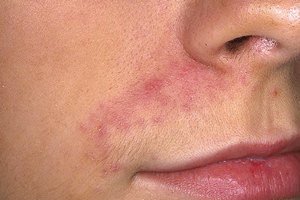
Ointments, gels and creams independently selected in a cosmetic store or pharmacy do not help. A sick person becomes depressed, avoids contact with people, and limits his social circle.
Perioral dermatitis may vary in severity in different people. In some cases, the matter is limited to a few pimples, in others, a severe rash appears.
There are numerous reviews on the Internet from people who have experienced what perioral dermatitis is.
Causes of perioral dermatitis
The exact causes of the disease are unknown, but doctors believe that it is primarily an allergic process.
The appearance of a rash is usually preceded by contact with any allergen, so one of the treatment measures is a special diet.
The diet is aimed at eliminating from the diet foods that are known to cause allergies.
It is difficult to single out any one allergen that causes dermatitis on the face.
These can be climatic factors, chemicals, medicinal ointments and even tooth powder. Fluoridated toothpastes are especially likely to cause oral dermatitis.
It is reliably known that corticosteroid (hormonal) ointments, often used to treat dermal diseases such as eczema, can cause oral dermatitis.
These compounds are highly effective in curing dermatological diseases, but they change the structure of the dermis, lead to atrophy of skin fibers, and disturb the color of the skin - this leads to the fact that the skin becomes unable to perform its functions.
Microorganisms penetrate into it and cause inflammation, expressed in the form of rashes, pustules, pimples, which ultimately leads to perioral dermatitis.
The causes of perioral dermatitis can be very different. One of them may be a decrease in immunity due to climate change, or excess solar radiation.
If a person has allergic rhinitis, asthma or simply sensitive skin, then he is at risk.
The majority of patients with oral dermatitis have disturbances in the functioning of the gastrointestinal tract and endocrine system, and there are nervous diseases.
If treatment with hormonal ointment does not lead to the appearance of dermatitis on the face, then do not delude yourself ahead of time. A rash on the face appears after the ointment is stopped.
Also, if you show “independence” and use corticosteroids without a doctor’s prescription to treat oral dermatitis, then you need to be prepared for the fact that even if the rash disappears, after stopping the drug it will appear again, affecting a larger area of the face.
Important! Oral dermatitis is not treated with corticosteroid (hormonal) drugs - instead of healing, they contribute to the further spread of the disease.
The causes of the disease may be changes in hormonal levels resulting from menopause or taking oral contraceptives.

Hormonal levels change greatly during pregnancy, which can cause dermatitis on the face.
It is not possible to fully treat oral dermatitis in pregnant women, but you need to know that it does not pose harm to the mother and the unborn child.
Treatment of dermatitis on the face
Treatment of any skin disease, including perioral dermatitis, is a long process. The duration of treatment is at least one and a half months. In advanced cases, treatment can last up to three months.
A doctor should treat dermatitis, and the sooner you go to him, the faster a positive result will be obtained.
Treatment, organized according to all the rules and leading to the disappearance of the rash, does not guarantee that perioral dermatitis will not make itself felt again.
Relapses can happen. So, where should you start treating oral dermatitis if your doctor has diagnosed this?
To begin with, so-called zero therapy is carried out. You need to stop using any cosmetics and medicinal ointments, fluoridated toothpaste.
The rash may get worse after stopping corticosteroids, but things should get better after a few weeks.
Keeping in mind the allergic nature of dermatitis, you can take antihistamines during zero therapy.

If zero therapy does not help, antibiotics are used. For oral dermatitis, antibiotics are a fairly effective measure and can completely cure the disease.
The doctor will prescribe treatment, which includes Minocycline or Doxycycline tablets, as well as Tetracycline or Metronidazole tablets or Metronidazole cream. Instead of Metronidazole cream, Erythromycin gel can be used.
The results of antibiotic treatment can be seen within three weeks. By this time, the skin is noticeably improving, but treatment should not be stopped prematurely.
To prevent antibiotics from harming the body, during treatment for perioral dermatitis, an additional course of drugs is taken to maintain intestinal microflora.
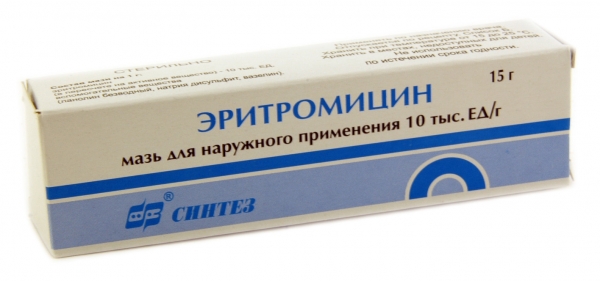
An approximate treatment regimen would look like this:
- Doxycycline, Minocycline or Tetracycline (dosage must be prescribed by a doctor) 2 times a day until the rash disappears, then the dose is halved and antibiotics are taken for another month;
- Metrogyl gel in the morning and erythromycin ointment in the evening.
No skin disease is complete without local treatment. A well-chosen ointment or gel can relieve symptoms and reduce inflammation.
In the treatment of oral dermatitis, Elidel cream with pimecrolimus, a substance belonging to the group of immunomodulators, showed good results. The gel is able to reduce the skin's response to the allergen.
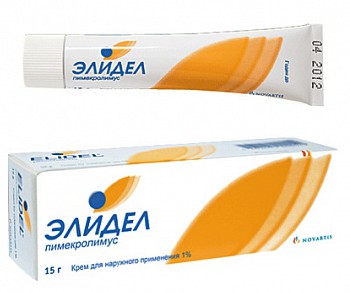
Facial care for perioral dermatitis
Treatment can be supplemented with various folk remedies. A strict diet may be required, but women are no strangers to limiting their diet for the sake of beauty.
The idea is to remove from the diet everything that leads to allergies and increases the activity of the sebaceous glands:
- spicy fatty and fried foods;
- exotic fruits;
- milk;
- sweets.
The diet limits the consumption of fish, caviar, mushrooms, and table salt. Dieting doesn't mean you have to go hungry. Meals should be regular, dishes are prepared from foods that are as rich in fiber as possible.
- Lotions from string, celandine, plantain. Lotions are made three times a day;
- Compresses with flaxseed oil - mix flaxseed oil and honey in equal quantities, heat in a water bath and pour in a little juice onions. A cloth is soaked in the mixture and applied to the affected areas of the skin;
- Pumpkin mask. The pulp of the vegetable is grated and the pulp is applied to the skin;
- Homemade ointments containing sulfur and tar.
Good folk remedies for dermatitis are:
- birch buds;
- oak bark decoction;
- aloe and kalanchoe juice;
- horsetail
They wash their face with decoctions of these plants, and then leave the skin to dry naturally without wiping it with a towel.
Bee products help get rid of oral dermatitis. Any beekeeping products have a bactericidal effect and can become medicinal folk remedies.
However, in this case it is undesirable to use honey for treatment, since it is an allergenic product.
To treat oral dermatitis with folk remedies, it is better to use propolis by making an ointment from it at home.

To prepare the ointment, combine 1 part propolis and 4 parts of any vegetable oil, heat in a water bath until the propolis dissolves.
So, perioral dermatitis is not life-threatening, but it does cause a lot of trouble. To avoid getting this disease, you should not subject your skin to aggressive or excessive care; you should hide your face from the wind and sun.
If the disease has begun, then it should be treated after consulting a doctor. A complex that includes treatment with antibiotics and folk remedies, and diet helps with perioral dermatitis.
Perioral dermatitis (rosacea-like dermatitis, perioral dermatitis, steroid dermatitis, flight attendant disease) is a chronic recurrent inflammatory disease of the skin, which mainly affects the skin around the mouth, and less often the cheeks, nose, lower eyelids and forehead. A typical manifestation of perioral dermatitis is that the strip of skin that is adjacent to the red border of the lips is not affected.
The first cases of the disease were recorded in the 50s of the 20th century. IN recent years The incidence of perioral dermatitis has decreased and it is now diagnosed in approximately 1% of the population. People with fair skin are more susceptible to perioral dermatitis. The disease primarily affects women aged 20–40 years, but also occurs in males. Children are susceptible to this type of dermatitis, regardless of gender.
Source: img-fotki.yandex.ru
Causes of perioral dermatitis and risk factors
The causes of perioral dermatitis are not completely clear.
The disease often develops against the background of the use of local medicines, which include corticosteroids, for the treatment of other dermatological pathologies (acne, acne, rosacea, eczema, etc.). Also, the occurrence of perioral dermatitis can be promoted by chapping of the skin of the face, prolonged exposure to direct sunlight, excessive use of decorative cosmetics, especially low quality.
Risk factors for developing perioral dermatitis include:
- diseases of the gastrointestinal tract;
- neurological disorders;
- chronic infectious processes;
- hormonal imbalances;
- taking oral contraceptives;
- allergic reactions;
- decreased immunity;
- stress;
- hypovitaminosis (especially deficiency of vitamins A and E);
- increased sensitivity of facial skin;
- using fluoride toothpaste;
- wearing dentures;
- change in climatic conditions.
In children, perioral dermatitis can occur during teething, with increased salivation, with prolonged use of a pacifier, as well as with the use of inhalers or sprays that contain hormones.
Forms of the disease
Depending on the characteristics of the clinical picture, there are two main forms of perioral dermatitis - ordinary and granulomatous (found mainly in children).
Symptoms
The disease debuts with the appearance of bright red or pink raised areas on the skin around the mouth, which resemble acne. Further, areas of the skin of the cheeks, nose, forehead and lower eyelid may be involved in the pathological process. The elements of the rash typically merge with each other to form clusters or solid spots. Some elements may be filled with clear liquid; after breaking through, such a rash turns into ulcers. The rash may be accompanied by a feeling of itching, burning, pain, and a feeling of skin tightness. Usually the rash is localized on the skin of the face symmetrically on the right and left sides. Swelling of the affected areas of the skin is often observed. As the pathological process progresses, the affected areas become covered with scales and crusts, which fall off over time. Premature removal of crusts can lead to the appearance of hyperpigmentation, and the pigment spots thus formed are subsequently very difficult to remove.
A characteristic sign of perioral dermatitis is a strip of skin approximately 4 mm wide around the red border of the lips, which is never involved in the pathological process.
Features of the disease in children
Perioral dermatitis in children before puberty usually occurs in the granulomatous form. This form of the disease differs in the nature of the rash and its location.
The rash elements in the granulomatous form of perioral dermatitis in children are flesh-colored, but sometimes pink or yellowish-brown. In most cases, rashes in children with this form of the disease are not accompanied by any subjective sensations, however, in rare cases, the pathological process may be accompanied by a burning sensation in the affected areas of the skin. Elements of the rash can be either single or merge, forming clusters. In addition to the area around the mouth, rashes can be localized around the eyes, near the ears, on the scalp, on the external genitalia, as well as on the skin of the upper and lower extremities.
Diagnostics
To make a diagnosis of perioral dermatitis, a medical history, objective examination and dermatoscopy are performed. In some cases, a histological examination may be required. If a secondary infection is suspected and there is a need to identify the infectious agent, bacteriological seeding of scrapings from the affected areas of the skin and/or the contents of the rash elements is carried out. The specific causative agent of perioral dermatitis has not been identified. Patients may be found to have an increased contamination of the skin with microorganisms, as well as fungi of the genus Candida and acne (Demodex folliculorum).
Differential diagnosis of perioral dermatitis with diseases such as sarcoidosis, rosacea, atopic dermatitis, seborrheic dermatitis, acne, eczema, herpes simplex, demodicosis, acne vulgaris is necessary.
Treatment of perioral dermatitis
When the diagnosis is confirmed, it is first necessary to stop taking medications that contain corticosteroids. In addition, you should avoid using decorative cosmetics and toothpaste containing fluoride. During treatment, it is recommended to avoid exposing the skin to direct sunlight. summer period use sunscreen.
Treatment of perioral dermatitis is medicinal. If itching is present, antihistamines are indicated, and sedatives may also be required. In case of pronounced swelling, diuretic drugs may be prescribed. When a bacterial infection occurs, local or systemic antibiotics are used. Taking vitamin complexes and immunomodulators is indicated.
For local treatment of perioral dermatitis, medications with a cooling effect in the form of a cream are used, as well as infusions of medicinal plants (calendula, chamomile, celandine, St. John's wort, etc.), lotions from a solution of boric acid.
Treatment of perioral dermatitis lasts from several weeks to several months, depending on the severity of the pathological process. Since the disease is prone to recurrence (especially with the use of cosmetics, decreased immunity and changes in climatic conditions), patients are advised to follow preventive measures.
Diet for perioral dermatitis
It is recommended to include cereals, legumes, lean meat (boiled in water or steamed), fermented milk products, wholemeal bread, green vegetables and fruits in the diet. You should avoid drinking tea, coffee, alcoholic beverages, citrus fruits, eggs, mushrooms, fish, sausage products, canned food, yeast dough products, spices, and limit the consumption of salt and sugar. To normalize metabolism, patients need plenty of fluids.
In some cases, bowel cleansing through enterosorbents and therapeutic enemas is required.
Possible complications and consequences
Perioral dermatitis is characterized by a relapsing course, and with relapses of the disease, more intense rashes and more painful sensations accompanying the appearance of the rash may be observed.
If perioral dermatitis is not adequately treated, pigment spots and scars may remain on the skin.
Cosmetic problems and discomfort experienced by patients with perioral dermatitis can lead to psychological problems, neuroses, depression.
Forecast
With timely diagnosis and properly selected treatment, the prognosis is favorable.
Prevention
To prevent the development of perioral dermatitis, it is recommended:
- timely treatment of diseases of internal organs, especially the digestive system;
- avoiding the use of medications for external use (ointments, creams) that contain corticosteroids;
- refusal to abuse decorative cosmetics;
- refusal to use low-quality cosmetics;
- refusal to use fluoride-containing toothpastes;
- balanced diet (limiting fatty, salty, spicy foods, alcoholic drinks);
- compliance with personal hygiene rules.
Video from YouTube on the topic of the article:
– the disease is not a pleasant one. In medicine, this disease is often called perioral or rosacea-like dermatitis. This is a fairly rare disease. This diagnosis is made to a small number of the population (less than 1%). According to statistics, perioral dermatitis is more common in young women aged 16 to 30 years. But today such a disease can also appear in a child, regardless of his gender and race.
General information about the disease
Perioral dermatitis is an inflammatory disease that develops on the face in the perioral area. “This disease is often confused with acne, which is why people are in no hurry to consult a dermatologist, wasting valuable time and aggravating the situation.” The fight against acne with cosmetics only becomes an additional impetus for the development and spread of skin rashes.
A child aged 7-13 years is more likely to develop granulomatous perioral dermatitis on the face.
Some classify this type of disease as a type of rosacea. Despite the similarity of the clinical picture, these skin lesions differ in the nature of the rash. If the doctor mentions the diagnosis of rosacea-like dermatitis, this means that the patient has perioral dermatitis, but not rosacea.
Causes of the disease or risk factors
As mentioned above, the disease in question most often occurs in women under 30 years of age. Children and men are rarely diagnosed with this condition. However, there are a number of factors that can trigger the appearance of perioral dermatitis. These include:
- drugs containing steroids: frequent use of ointments or creams containing steroids (prednisolone, hydrocortisone) causes the development of the disease. This manifestation of the disease is called perioral steroid dermatitis. Doctors were able to establish a direct relationship between the development of this type of disease and the patient’s use of an ointment containing hormones. Such drugs are used mainly to treat eczema. After applying the drugs, traces of it may remain on the hands and upon contact with the face, in such cases, oral dermatitis may develop. The peculiarity of the development of steroid perioral dermatitis is that when using an ointment that contains hormones, the disease does not manifest itself in any way, but when they are discontinued, the rash reappears, but with more pronounced symptoms;
- Cosmetics: Some creams and lotions can cause perioral dermatitis. In particular, a similar skin rash occurs after using foundation;
- Fluoride toothpaste: Fluoride, found in some toothpastes, can worsen existing dermatitis. In such cases, the perioral rash becomes more pronounced;
- weather conditions: strong winds, prolonged exposure to direct sunlight or severe frost can serve as an impetus for the development of the disease or significantly complicate its course;
- hormonal contraceptives: often in women using hormonal contraceptives, arise. If they occur, the drugs should be discontinued and alternative contraceptives should be selected.

Symptoms of disease development
The main symptom of perioral dermatitis is the appearance of a characteristic rash in the area around the mouth. It is characterized by small pimples or pinpoint bumps that are pink or red in color. Outwardly, these symptoms resemble acne or acne, so people may not even realize that they have oral dermatitis on their face. The skin under the rash also acquires a pinkish tint and becomes rough to the touch due to numerous small formations in the form of pimples and tubercles.
Locations of the rash:
- chin;
- cheeks (rarely).
In the area around the lips, the rash almost never appears or appears to a minor extent. Thus, a kind of circle is formed surrounding the perioral area. In some cases, oral dermatitis appears near the eyes from the temporal area. If the rash and redness spreads to the area around the eyes, then this disease is called periorbital dermatitis, which is similar in symptoms and manifestations to perioral dermatitis.
The intensity of the rash can be varied: from the appearance of several bumps to pronounced rashes covering a relatively large area of skin on the face. In most cases, patients do not experience pain or itching in the affected areas of the skin.
Perioral dermatitis is not a health hazard. Patients are more concerned about the aesthetic side of this issue. Under no circumstances should defects caused by the disease be masked with cosmetics (apply foundation to the affected areas).
Rosacea-like dermatitis has slightly different symptoms. The rashes are located symmetrically on the face and only in certain places: in the nasolabial fold, on the chin, bridge of the nose, cheeks and, in rare cases, on the skin of the lower eyelid. In this case, the rash consists of small nodules that have the shape of a half-ball with a small pustule in its center. Most often they are located singly, but in rare cases they can merge with each other.

Prevention and drug treatment of perioral dermatitis
If left untreated, the symptoms of the disease can remain on the face for quite a long time: months and even years. If you start therapy on time, then after a few weeks all manifestations of the disease will disappear.
The first thing to do in such situations is to give up cosmetics. If the patient is using steroid ointments, they should be forgotten for a while and an alternative treatment option for perioral dermatitis or a disease that requires the use of the above-mentioned drugs should be found. Fluoride toothpaste should be replaced with another one. Rosacea-like dermatitis, like oral dermatitis, can be triggered by the factors described above. Therefore, recommendations regarding prevention apply in both cases.
These measures may cause more intense rashes. There is no need to be afraid of this. Within a couple of days the condition of the skin will improve.
As a medicinal treatment for adults and children, a course of tetracycline antibiotics is prescribed. If the diagnosis of “perioral dermatitis” is made in a timely manner, then ointments containing antibiotics are prescribed. Such treatment can take at least a month, and the first results will appear only after a couple of weeks.
The mechanism of action of antibiotics to treat perioral dermatitis is not fully understood, but in most cases it is the most effective solution.
After the rash disappears, you should refrain from applying cosmetics to your facial skin for at least three months. This may cause a relapse of the disease.
Rosacea-like dermatitis is very treatable. Its therapy consists of eliminating the irritating factors that caused the disease. Under no circumstances should corticosteroids be used to treat this type of skin manifestation.
Remember that self-diagnosis and self-medication may not only not give a positive result, but also significantly worsen the disease. Only a dermatologist, based on an examination, will select the correct treatment for a specific case, thanks to which you will forever forget about such an unpleasant disease.
Auto. Gavrilenko Yu.
Oral dermatitis is a rare skin disease that has a chronic course. Usually affects girls and women 18-45 years old. It occurs less frequently in men and children. The disease also has a name perioral, steroid, rosacea-like dermatitis.
Irritation in the perioral zone causes psychological discomfort. How to cure this disease at home? What are the reasons for its occurrence?
Peculiarities
Oral dermatitis is a pathological process that affects the epidermis in the form of papular-spotted elements on the chin, around the mouth, and in adjacent areas on the face. The disease affects only 1% of the population, and 93% of all patients are women. Children suffer from such dermatitis less often due to the fact that they do not use cosmetics and hormonal ointments.
Oral dermatitis is a long-term pathology. The provocateur can be any cosmetic cream and drugs with corticosteroids. They can destroy the structure of collagen and elastin and affect the vascular system, causing erythema, microtears in the epidermis, and telangiectasia.
Causes of the disease
 The exact causes of oral dermatitis have not been established. But experts have identified factors and causes influencing the development of the disease.
The exact causes of oral dermatitis have not been established. But experts have identified factors and causes influencing the development of the disease.
Women often use moisturizing, emollient, nourishing creams or medications with fluorinated corticosteroids. They destroy the structure of collagen and elastin and damage blood vessels.
Conditionally pathogenic microflora on the skin is present in all people. She starts to grow as soon as a person's immunity decreases. An inflammatory process occurs on the skin.
Other causes of oral dermatitis:
- hormonal imbalance in the body;
- use of incorrectly selected cosmetics;
- chronic infectious focus;
- disruptions in the nervous and endocrine systems;
- intolerance by the epidermis to components of cosmetics;
- use of fluoride-containing toothpastes;
- tendency to allergies;
- excess ultraviolet radiation;
- weakened immunity;
- gastrointestinal diseases;
- change in climatic conditions;
- bronchial asthma;
- allergic rhinitis;
- dentures;
- abrupt withdrawal of hormonal cream.
Quite often oral dermatitis is caused by the following drugs:
- petrolatum;
- isopropyl myristate;
- cinnamon flavoring;
- lauryl sulfate;
- paraffin.
Causes of oral dermatitis in a child:
- the use of hormonal ointments to eliminate abscessive lesions of the epithelium;
- immune imbalance in a growing body;
- hormonal imbalance;
- hypovitaminosis, which occurs due to a lack of nutrients.
During perinatal age, infants sometimes experience hormonal changes due to the hormones accumulated by the mother during pregnancy. This is manifested by oral dermatitis, but this is a very rare occurrence.
Oral dermatitis - video
How to treat oral dermatitis?
 Treatment of oral dermatitis should be carried out comprehensively and in stages. During preparation for treatment, the doctor changes everything hormonal drugs, cosmetics and personal care products. The epidermis must rest. The use of hormonal drugs should be discontinued gradually to avoid exacerbation of the pathology.
Treatment of oral dermatitis should be carried out comprehensively and in stages. During preparation for treatment, the doctor changes everything hormonal drugs, cosmetics and personal care products. The epidermis must rest. The use of hormonal drugs should be discontinued gradually to avoid exacerbation of the pathology.
Proper facial skin care is important. If the manifestations of oral dermatitis are not severe, you can use a decoction of chamomile and sage. For complicated symptoms, it is better to use special emulsions with oil base. For acute manifestations, it is possible to use naphthalene-tar paste 2%.
Basic ointments for the treatment of oral dermatitis and other remedies:
Ointments for oral dermatitis are the main methods of treatment.
But additional drugs are also needed:
In the presence of infectious foci, it is necessary to treat concomitant pathologies, as well as normalize the endocrine and nervous systems, and the functioning of the gastrointestinal tract. Immunostimulating drugs are also prescribed to treat oral dermatitis. Monthly courses of vitamins B, C, A, and folic acid will help.
In particularly severe cases The therapy is complemented by physiotherapy, cryomassage and other therapeutic procedures.
Treatment of oral dermatitis during pregnancy
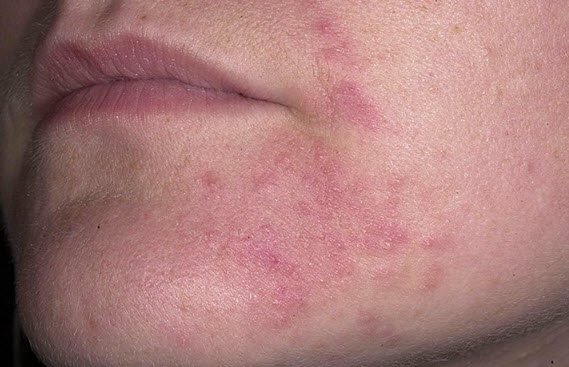 During pregnancy, oral dermatitis occurs due to a weakened immune system. early. Antibiotics are not suitable for treating pregnant women in the first 3 months. If there are no contraindications, the doctor will prescribe antibiotic therapy in the second trimester.
During pregnancy, oral dermatitis occurs due to a weakened immune system. early. Antibiotics are not suitable for treating pregnant women in the first 3 months. If there are no contraindications, the doctor will prescribe antibiotic therapy in the second trimester.
Manifestations of oral dermatitis on the skin are red or pinkish. After some time, the rashes become pigmented. Full therapy is prescribed only after a complete examination of the body.
Is it possible to cure oral dermatitis with folk remedies?
Traditional medicine
Folk remedies for oral dermatitis will help cure the disease only in combination with drug therapy. The following recipes are used:
- Help relieve acute symptoms lotions with decoctions of string, plantain leaves, calendula, chamomile flowers. Lotions are applied to inflammation and replaced with fresh ones several times a day.
- Compress with linseed oil. Mix 50 g of honey and oil, heat the mixture a little, add 25 g of onion juice. The composition is applied to a sterile napkin and applied to the rash.
- A decoction of birch buds is used for lotions externally and internally. b. For oral dermatitis, it soothes the skin.
- 20 g of propolis are mixed with 80 g of oil, dissolve in the oven, lubricate your face with it.
- The face is lubricated with fresh aloe and Kalanchoe juice.
Treatment of oral dermatitis folk remedies - an auxiliary set of measures. Physician approval is required before starting therapy.
Diet
To eliminate the symptoms of oral dermatitis, the specialist also prescribes a hypoallergenic diet. If there is no effect, it is replaced short therapeutic fasting. The scheme is selected individually.
Skin diseases are considered a very important problem in modern medicine. It is the epithelium that protects the body from the outside world. It is a barrier between important systems, organs and harmful agents environment. Under the influence of external aggression, various dermatological diseases arise.
One of these diseases is oral dermatitis on the face, treatment and reviews, the causes of which we will consider in this article.
Features of the disease
It, oral dermatitis, is a pathological process in which the epidermis is damaged in the form of papular-spotted rashes in the following areas of the body:
- chin;
- around the mouth;
- adjacent areas of the face.
According to statistics, the disease is quite rare. It affects only 1% of the population. Representatives of the fair sex aged 20-40 are at risk.
The patient feels physical, aesthetic, and psychological discomfort due to redness on the skin, growing irritation, and small papules covering large areas of the epithelium.
Of the 1 percent of people suffering from oral dermatitis, only 5-7% are children, the remaining 93-95% are women. Children get sick less often because they do not use cosmetics or hormonal ointments.
The causes of this pathology in children are:
- the development of pustular lesions of the epithelium, in which parents use hormonal ointments for therapeutic purposes;
- the presence of an immune imbalance within the growing organism;
- hormonal changes within the body, during which disturbances occur in the structure of the dermis and its functioning;
- the presence of hypovitaminosis, which occurs as a result of a lack of nutrients.
Causes of oral dermatitis
This type of dermatitis occurs most often in women. They intensively use moisturizing, softening, nourishing creams, and medications that contain fluorinated corticosteroids. Under their influence, the structure of collagen and elastin fibers is destroyed and blood vessels are damaged. The result of these processes is thinning of the epithelium, the formation of erythema, and telangiectasia.
The healthy dermis of every person contains opportunistic microorganisms. There are a lot of them, but they are not dangerous. Increased growth of pathogenic flora begins with a decrease in immunity. Inflammatory process on the epidermis begins due to a decrease in its protective functions.
Common causes of oral dermatitis are:
- hormonal crisis;
- use of incorrectly selected cosmetics;
- the presence of chronic foci of infection;
- disturbances in the functioning of such systems: endocrine;
- increased sensitivity of the epidermis to the components of used cosmetics;
- use of toothpastes (fluoride);
- decrease in the bactericidal properties of the epithelium;
- predisposition to allergies;
- decreased immunity;
- diseases of the gastrointestinal tract.
The doctor will tell you more about what oral dermatitis is in this video:
Symptoms
This type of dermatitis develops gradually. It can be hidden for weeks or months. After this period, erythema (usual redness) appears on the epithelium. Then papules appear, some can reach the size of a millet grain. As the disease progresses, the resulting papules form large lesions called plaques. New papules form around these plaques.
These processes are accompanied by symptoms such as:
- dry epithelium;
- peeling;
- crust formation;
- the appearance of a clear boundary between the lips and the affected area around the lips.
The rash, which is the main symptom of this disease, spreads to the nasolabial triangle and chin. They are characterized by polymorphism, i.e. consist of many elements. Papules that appear on redness have a whitish tint. Their diameter is approximately 2-3 mm.
Diagnostics
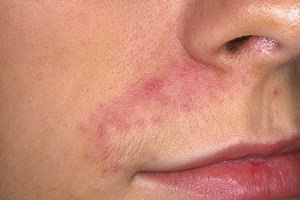 To make an accurate diagnosis, it is necessary to carry out bacterial culture of the scraping and the contents of the rash. These tests are performed to isolate microflora from the affected area and determine the pathogen.
To make an accurate diagnosis, it is necessary to carry out bacterial culture of the scraping and the contents of the rash. These tests are performed to isolate microflora from the affected area and determine the pathogen.
Only a dermatologist can clarify the diagnosis. It is necessary to carry out differentiated diagnostics to distinguish the disease from the following inflammatory processes:
- diffuse neurodermatitis;
- steroid, rosacea;
The next section will tell you how and how to treat oral dermatitis on the face and other parts of the body.
Treatment
Therapeutic
In order for the treatment of this disease to bring a quick, desired effect, it should be carried out comprehensively. Duration of therapy – 1.5-2 months. It depends on the severity of the disease. Treatment of oral dermatitis involves the following actions:
- During the period of exacerbation of the process, you should stop using cosmetics. This event is necessary for the epidermis to rest and acquire a new structure.
- You should categorically refuse to use various hormone-containing ointments. If the patient uses such facial products, it is prohibited to abruptly stop using them. This may cause an exacerbation of the disease. Reducing the frequency of use of such products should be done gradually.
- It is recommended to use antihistamines ("", "", "L-cet"). They reduce swelling.
- You should follow a diet for oral dermatitis on the face, which consists of proper nutrition. It is necessary to exclude spices, smoked meats, spicy, fried foods. Food should contain a large amount of vitamins. Boiled plant foods are recommended. It is recommended to limit the consumption of foods that provoke the development of allergies (mushrooms, carrots, eggs, fish, caviar, soy products).
- The use of antibacterial drugs is indicated. The most effective drug turned out to be "". The duration of therapy with this antibiotic is several weeks.
- It is necessary to treat the epithelium with antiseptic solutions (Dekasan, Chlorhexidine). This measure is necessary if there is a possibility of secondary infections.
- It is necessary to carry out local therapy with ointments including metronidazole. It is undesirable to use glucocorticoids for local therapy. The exception is exacerbation of this type of dermatitis with the manifestation of sudden withdrawal syndrome.
It is an integrated approach that guarantees complete cure of the disease in a short time.
The doctor will tell you about ointments and other remedies for oral dermatitis in the video below:
Medication
For external use, the following products are considered effective:
- Skinoren cream.
- Protopic milk (0.03% is used for the face, 0.1% for the body);
- ointments with metronidazole.
Among the effective antibiotics are:
- "Doxycycline."
- "Minocycline."
- "Tetracycline".
To eliminate severe itching and burning, the following antihistamines are used:
- "Cetrin".
- "Clemastine."
Also effective in the treatment of oral dermatitis are:
- physiotherapy. It involves performing an ice massage with liquid nitrogen;
- vitamin therapy;
- use of sedatives (for emotional instability).
Read below about the treatment of oral dermatitis on the face and other parts of the body with folk remedies with positive reviews.
Traditional methods
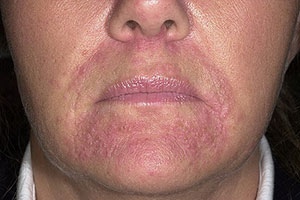 This disease can be treated quite successfully using traditional methods. If the dermatitis is severe, taking medications is mandatory. Using folk recipes as medicines, you should monitor the reaction of the body and epithelium. If allergic manifestations are detected, you should stop using the product.
This disease can be treated quite successfully using traditional methods. If the dermatitis is severe, taking medications is mandatory. Using folk recipes as medicines, you should monitor the reaction of the body and epithelium. If allergic manifestations are detected, you should stop using the product.
In the fight against oral dermatitis, the most effective means are:
- Aloe/Kalanchoe juice.
- Infusion of birch buds, which is prepared from 1 tbsp. l. kidneys and a glass of water. Drink this remedy and wipe the affected area with dermatitis.
- A strong infusion of the following herbs: chamomile, calendula, plantain, string. It is used to wipe the epithelium.
- Decoction of oak bark. It is used for compresses and lotions.
- Pumpkin pulp with juice.
- A solution of baking soda, which is prepared from 1 tsp. soda and a glass of water.
- Sea, thermal water is used for frequent irrigation of the dermis.
- Ointments prepared on the basis of tar and sulfur.
- Propolis (20 gr.) with oil (80 gr.). The mass is dissolved in the oven and used to lubricate the skin.
Now you know how to cure oral dermatitis on the face and other parts of the body, let's talk about preventing the disease.
Prevention
Prevention measures include:
- prohibition of the use of corticosteroid ointments, creams;
- diet;
- observing personal hygiene rules;
- limiting the use of cosmetics containing allergic components;
- using high SPF cosmetics all year round;
- limiting the use of fluoride toothpastes.
Complications
In cases where the disease becomes aggressive, the following complications may occur:
- formation of weeping;
- irritation of the epithelium.
Forecast
For this disease, the prognosis is conditionally favorable. This pathology does not affect the patient’s ability to work. This problem has only a purely psychological side.
The video below will tell you how to distinguish oral dermatitis from rosacea:




